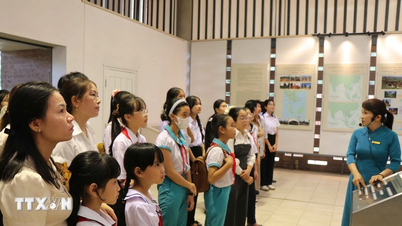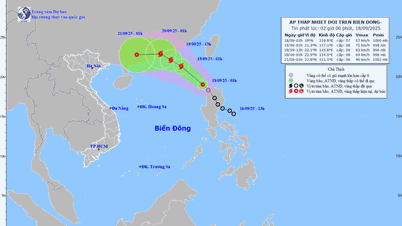Without monthly allowances and pensions, many people still have a heavy burden of making a living in their old age (Illustration photo)
In that context, the issue of ensuring social security for the elderly has become more urgent than ever. However, the current reality shows that there are still many elderly people living without pensions, without monthly allowances and without support. This is a worrying “social security gap” in policies for the elderly.
“The security gap”
According to the Vietnam Social Security (VSS), by 2024, Vietnam will have nearly 17 million elderly people, of which more than 2.47 million elderly people will participate in social insurance (2.2 million elderly people have participated in social insurance and are receiving monthly pensions with an average pension of nearly 6 million VND/month).
Analysis by the International Labor Organization (ILO) in 2022 shows that Vietnam is among the countries with relatively low pension coverage rates. While the global average pension coverage rate is 77.5%, in Vietnam it is only approximately 40%. In many advanced European and Asian countries such as Korea and Japan, the pension and allowance coverage rate for the elderly is 80-100%. This shows that Vietnam still has a lot of work to do to ensure the goal of universal coverage for the elderly.
Currently, the elderly aged 60-79 who meet the conditions can receive the following income: Monthly social insurance pension (if they have paid enough and are of retirement age); social pension allowance (for the poor, disabled, ethnic minorities in especially difficult areas) and allowance for people with meritorious services.
However, in reality, most of the elderly aged 60-79 are not eligible for any benefits. Only after the age of 80 do the elderly receive general social benefits. The 20-year gap from 60-80 is the period when the elderly face many health risks, medical expenses and need to be guaranteed income. Meanwhile, this group is overlooked in the social security system.
From July 1, 2025, the Social Insurance Law 2024 officially takes effect, in which the outstanding new point is the establishment of a multi-layered social insurance system, including: Level 1 - social pension benefits paid by the state budget; Level 2 - compulsory social insurance and voluntary social insurance and Level 3 - supplementary retirement social insurance - voluntary according to the contribution-benefit principle.
In particular, the first floor is an important highlight: Social pension benefits will start from age 75 (currently 80). At the same time, people aged 70-74 from poor/near-poor households will be considered for benefits. This change contributes to shortening the current "security gap" by 5-10 years; at the same time, increasing the coverage rate of beneficiaries, creating motivation to participate in social insurance among currently fragmented groups.
In addition, employees who have reached retirement age but are not eligible for pension or social benefits will receive monthly benefits from the social insurance contributions they have made (if they do not withdraw their social insurance contributions in one lump sum). The level of benefits is calculated based on the time and level of contributions, at least equal to the level of social benefits.
Towards forming a multi-layered, flexible social insurance system
The addition of a social pension benefit layer to the social insurance system in Vietnam marks a significant step forward in approaching the multi-layered social security model that has been applied in many countries around the world . According to the ILO's recommendation, a comprehensive pension system should be designed based on three layers: (1) Universal social protection (non-contributory), (2) basic pension insurance (contributory) and (3) additional forms of retirement savings (voluntary or occupational pensions).
In developed countries such as Germany, Sweden, Japan and South Korea, pension systems often operate with a combination of all three tiers. For example, in Japan, all citizens aged 65 and over receive a basic pension from the government regardless of whether they have contributed to it or not. This mechanism helps ensure that no elderly person falls into absolute poverty due to lack of pension.
With the 2024 Social Insurance Law, Vietnam is approaching this logic by establishing a flexible, multi-layered social insurance system. The “multi-layered” approach not only helps expand coverage, aiming for universal social insurance, but also ensures fairness among different groups of workers from the formal and informal sectors to those who are unable to contribute.
In addition, allowing employees to receive monthly benefits from their own contributions in case they are not eligible for pension also demonstrates the spirit of "no one is left behind" in the new social security policy.
The important point is that the policy is not only aimed at “assistance” but also encourages people to participate in social insurance early, continuously and long-term, thereby creating a sustainable pension system. However, besides opening up many opportunities to improve the social security situation for the elderly, the effective implementation of the Social Insurance Law 2024 still faces many challenges and difficulties.
In terms of budget resources, expanding the scope of social pension benefits, adjusting the age of beneficiaries to an earlier age, increasing the level of periodic benefits, etc. will put great pressure on the state budget. According to estimates by the Ministry of Labor, War Invalids and Social Affairs (now the Ministry of Home Affairs), just paying monthly social benefits to the elderly aged 80 and over currently costs thousands of billions of VND each year. If the age is lowered to 75, this number will certainly increase sharply. This requires careful financial preparation, especially in the context of Vietnam's rapidly aging population.
Currently, social insurance coverage remains low in the informal sector, which accounts for more than 60% of the country's workforce. According to statistics from Vietnam Social Security, by the end of 2024, only about 38% of the working-age workforce will participate in compulsory or voluntary social insurance. This leads to a large proportion of the elderly in the future not having a pension, continuing to put pressure on the social welfare system.
In addition, people's awareness of social insurance policies is still uneven. Many workers, especially in rural areas or freelancers, still consider social insurance a burden or misunderstand that paying social insurance is "deducting salary" or "ineffective". This is the reason why the phenomenon of withdrawing social insurance at one time, although it has decreased recently, is still common, creating a "retirement gap" in the future.
In order for the social pension policy and the multi-layered social insurance system to maximize its effectiveness, aiming at universal coverage, in the coming time, Vietnam Social Security will promote policy communication and propaganda in an easy-to-understand and familiar form, emphasizing the long-term benefits of participating in social insurance, especially for young people. Real stories from retirees who are receiving stable pensions, compared to those without pensions, will create a clear cognitive effect.
In the context of a rapidly aging population, building a strong and comprehensive social security system is not only an obligation but also a long-term strategy to ensure sustainable national development. If the "pension gap" of the elderly is not filled, it will be a major challenge in terms of humanity, society and economy. Vietnam is on the right track when implementing multi-level social insurance reform. The next important thing is to turn policy into action, policy into practice so that no one is left behind on the journey to a peaceful old age.
People’s awareness of social insurance policies is still uneven. Many workers, especially in rural areas or freelancers, still consider social insurance a burden or misunderstand that paying social insurance is “deducting salary” or “ineffective”. This is why the phenomenon of withdrawing social insurance at one time, although reduced recently, is still common, creating a “retirement gap” in the future.
From July 1, 2025, the Social Insurance Law 2024 officially takes effect, in which the outstanding new point is the establishment of a multi-layered social insurance system, including: Level 1 - social pension benefits paid by the state budget; Level 2 - compulsory social insurance and voluntary social insurance and Level 3 - supplementary retirement social insurance - voluntary according to the principle of contribution and benefit"./.
Long An Province Social Insurance
Source: https://baolongan.vn/-khoang-trong-an-sinh-cua-nguoi-cao-tuoi-a195667.html




![[Photo] General Secretary To Lam chairs a working session with the Standing Committee of the Government Party Committee](https://vphoto.vietnam.vn/thumb/1200x675/vietnam/resource/IMAGE/2025/9/17/cf3d855fdc974fa9a45e80d380b0eb7c)


![[Photo] Science and Technology Trade Union honors exemplary workers and excellent union officials](https://vphoto.vietnam.vn/thumb/1200x675/vietnam/resource/IMAGE/2025/9/17/842ff35bce69449290ec23b75727934e)




![[Motion Graphics] Ha Tinh - important achievements in culture and society](https://vphoto.vietnam.vn/thumb/402x226/vietnam/resource/IMAGE/2025/9/18/c9bfa0d2110242209c02f0c9db811f44)


















































































Comment (0)